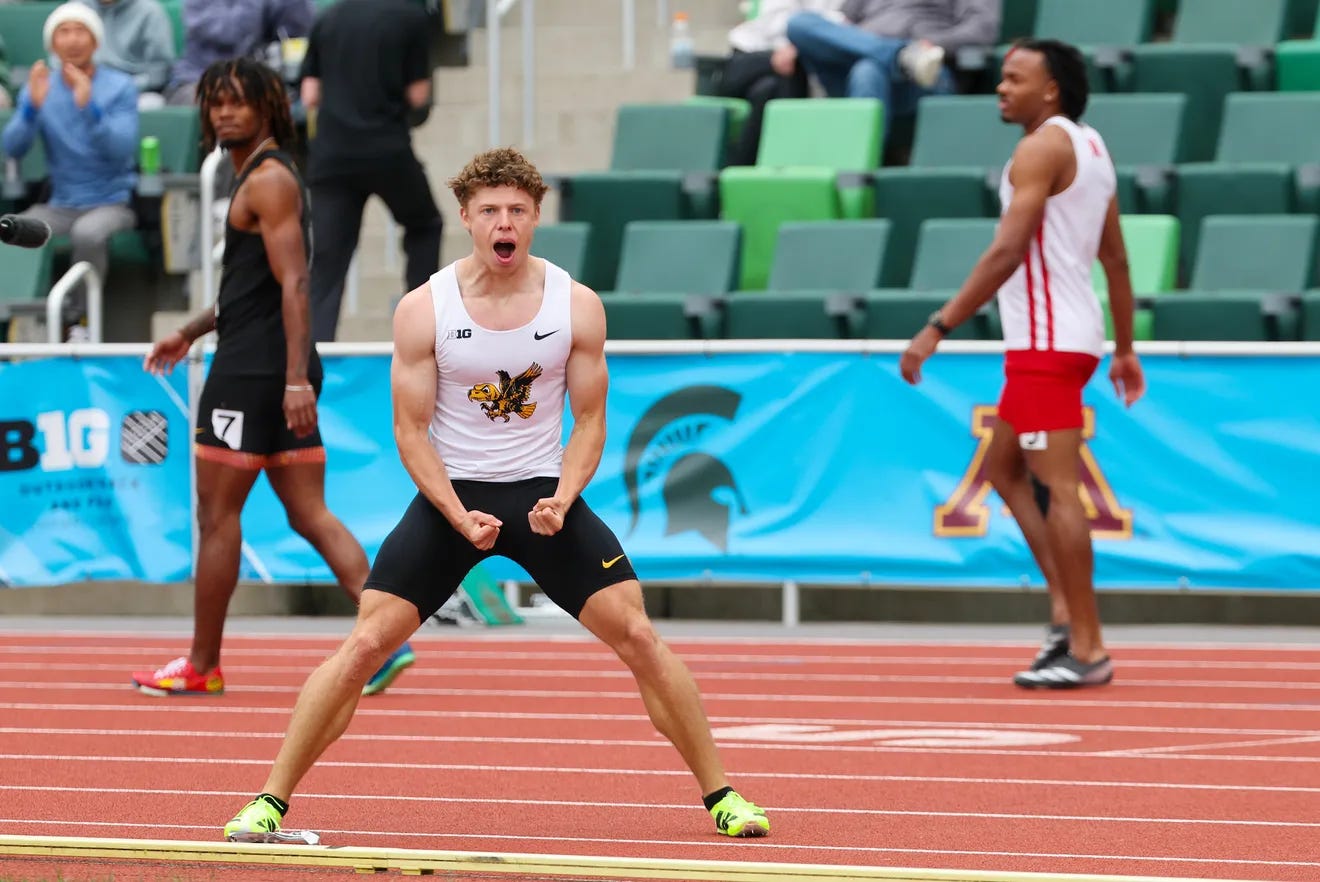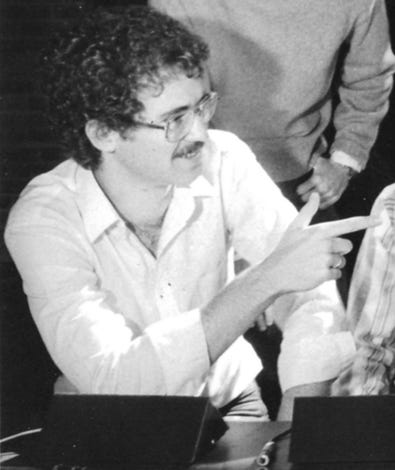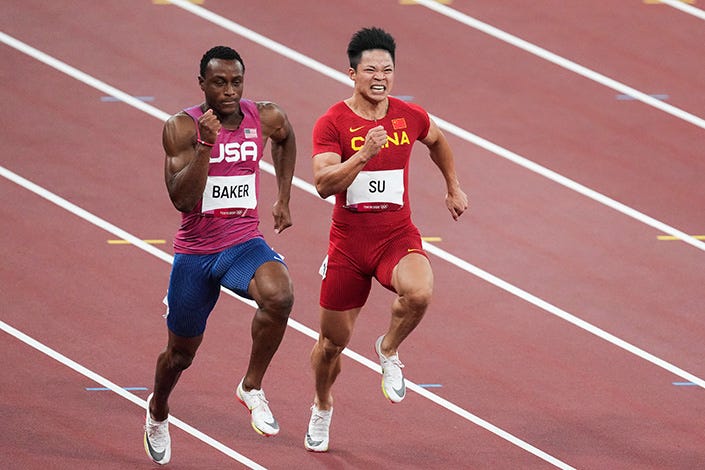U. of Iowa's White Athletes Roll On
Kalen Walker of Iowa runs a white American record 9.94 in the 100 meters to join Caitlin Clark, Cooper DeJean, and Riley Moss as mid-2020s white Hawkeye standouts.
In the 2020s, the University of Iowa is on a hot streak at proving Steve Sailer wrong — or at least overconfident — about how big the black-white gap is in basketball, football cornerback, and the 100 meter dash.
Most famously, Caitlin Clark, a 2024 graduate of the U. of Iowa, has become the most famous woman basketball player in the world, making huge amounts of money for the traditionally sad-sack WNBA while enduring racist anti-white racist violence from her opponents with impressive good grace.
Granted, the black-white gap in the men’s NBA is not as large as people may think: white players have won six Most Valuable Player awards in this century (Serbian Nikola Jokic 3, and 2 runners-up, Canadian Steve Nash 2, and German Dirk Nowitzki 1). But, still, it has been hard for white Americans not growing up in places as remote from black basketball dominance as John Stockton’s Spokane to thrive at the highest level of basketball.
Moreover, Iowa’s football team has also provided the NFL in the second half of the 2024 season with its first white two white starting cornerbacks since Jason Sehorn and the half white-half Thai Kevin Kaesviharn way back in 2003.
Second-year Iowa player Riley Moss started 14 games at cornerback for the Denver Broncos last fall.
And Iowa rookie Cooper DeJean started 9 regular season games at cornerback for the Philadelphia Eagles and all 4 postseason games. In Philadelphia’s Super Bowl victory four months ago, he intercepted a Patrick Mahomes pass and returned it 38 yards for a touchdown:
And last week …
Paywall here.
… at the NCAA Track & Field regionals at Texas A&M, Iowa sprinter Kalen Walker set a new record for white Americans by running a 9.94 100 meter dash.
This was at low altitude with a helping wind of 1.1 meters per (anything equal to or under 2.0 m/s is legal). That’s about the average helping wind for good times.
By the way, a large proportion of white American athletes who excel at black sports and/or positions seem to have curly hair. Is this because they are slightly black?
Perhaps. But 23andMe data suggests that is so rare that it’s unlikely.
Probably more likely is that they just have higher testosterone. For example, I had curly hair from roughly age 15 to 25. It was really distressing to suddenly have curly hair in the straight hair post-hippie early 1970s. But then, suddenly, curly hair came into fashion in the second half of the decade, much to my pleasure. Here’s me doing my Weird Al Yankovic impression in a Houston Chronicle article about my Rice U. College Bowl team just before my 21st birthday in 1979:
As you can see, I was feeling pretty good.
On the other hand, as I got older and my T level declined, my hair got straighter. Oh, well …
I played a lot of golf from 13 to 16, then played less golf and more team contact sports from 17-23, then played golf from 24 onward, which correlates closely with my hair curliness.
Walker is probably not going to win the NCAA championship in Eugene, Oregon because Arkansas’ Jordan Anthony ran 9.75 with a barely illegal 2.1 m/s helping wind.
But still … 9.94!
Walker’s time makes him the second fastest white man ever, behind only two-time Olympic medalist Christophe Lemaitre of France, who ran a 9.92 in 2011.
The fastest 100m time ever by a non-African was Su Bingtian of China’s 9.83 in the 2021 Tokyo Olympic semifinal, which was powered by an all-time great start:
By the way, Su’s hair is less limp than is common among the Chinese:
The all-time record is Jamaica’s Usain Bolt’s 9.58 at the 2009 Berlin World Championship:
Keep in mind that running shoes have gotten faster over the last six or eight year due to the incorporation of carbon fiber plates in the soles. So we are seeing a lot of times unknown since steroid testing was improved after Ben Johnson’s and Florence Griffith-Joyner’s overly-amazing times at the 1988 Olympics.
Still, it seems striking that four athletes who Smash Stereotypes have all emerged at the U. of Iowa in a few years. My general impression is that racial stereotyping is not a huge factor in why there are such distinct racial differences in high end performance in different fields. But I’ve assumed that stereotyping could play a negative role and that role models could play a positive role.
Hence, it wouldn’t be astounding if in the 2020s, tremendous white athletes tend to gravitate toward one college, such as Iowa, with a reputation of being fair to white athletes.
On the other hand, all four of the Iowa Big Four went to high school in Iowa.
For example, from Hawk Central last week:
How small-town Iowan Kalen Walker went from unknown to Big Ten 100-meter champion
Des Moines Register
Hawkeye track and field star Kalen Walker grew up in small-town Iowa and began his college career at Indian Hills Community College.
In May, Walker reached rare air, becoming one of the few Hawkeyes to win a Big Ten title in the 100-meter dash.
IOWA CITY — There aren't any stoplights in Eddyville, Iowa, population of around 1,000.
Eddyville is small-town, rural Iowa. Midwest countryside. Tight-knit community. Some local jobs come in the form of Cargill Corn Milling, Ajinomoto Animal Nutrition North America and Wacker Chemical Corporation, all of which have facilities in Eddyville.
Born in nearby Ottumwa, Kalen Walker grew up primarily in Eddyville. He attended high school at Eddyville-Blakesburg-Fremont, where his graduating class was in the neighborhood of 60 to 70.
This is the place that produced this year’s Big Ten Conference champion in the 100-meter dash.
On May 18, Walker’s time of 10.17 seconds edged out Southern California's Eddie Nketia,
For reasons that I don’t care to think about, USC (alma mater of O.J. Simpson) and UCLA (Kareem Abdul-Jabbar) are now in the upper Midwestern Big Ten college conference.
a former college football player, who recorded a time of 10.18. Among the others that Walker beat at Oregon's Hayward Field was former Ducks defensive back Rodrick Pleasant, who was a four-star prospect on the gridiron in high school.
Walker was nowhere near that.
He had no Division I or Division II track offers in high school and began his college career at Indian Hills Community College. That was further than either of his parents got in their athletic careers — neither one made it past the high school level. When Walker first got his opportunity with the University of Iowa's track and field program, it was as a preferred walk-on.
But in May, Walker reached rare air, joining two-time champion George Page, Tim Dwight and Justin Austin as the select few from the Iowa men’s program to win a Big Ten title in the 100 meters. And Walker did it in the new-look Big Ten, which includes four former Pac-12 programs.
Walker has gone from obscurity — an under-recruited, nationally unknown kid from Eddyville — to taking down the Goliaths of the collegiate track and field world and making a name for himself in the sport.
The story is so improbable that it’s reasonable to wonder: How was this even possible? …
Walker had pitched this idea to Iowa: What if he ran a 40-yard dash at halftime of an Iowa football game? On Oct. 26, 2024, it came to fruition. The recorded attendance for Iowa football’s game against Northwestern was more than 69,000, roughly 69 times the population of Eddyville.
In front of an eagerly watching crowd, Walker blazed across the turf.
He recorded a time of 4.15 seconds, topping the fastest time in NFL Combine history, which is 4.21.
Walker’s YouTube video, which provided a behind-the-scenes look at the experience, has more than 300,000 views.
You might think this pattern of the U. of Iowa white athletes Shattering Stereotypes would be of journalistic interest, but instead I mostly found articles worrying that the U. of Iowa wasn’t upholding diversity by being like all the other colleges. From Hawkeye Nation in the intellectually brilliant year of 2020:
’18 Athletic Department Study Showed Serious Racial Bias in Iowa Football
By Rob Howe Jul 20, 2020
IOWA CITY, Iowa – As University of Iowa football responds to public allegations of racial bias within the program—widespread on social media after a June 3 Tweet by Chicago Bears offensive lineman and former Hawkeye player James Daniels—a document obtained by Hawkeye Nation suggests the athletic department knew over a year ago about the significant problems and inequalities being alleged now.
The good news is athletics director Gary Barta and football coach Kirk Ferentz are taking action and working toward a more inclusive environment. That can’t happen soon enough for the more than 50 former and current Black football players who have alleged inequality.
A Kansas City law firm, hired by Iowa, is currently investigating the allegations and is expected to complete and submit its report by the end of this month.
The charges against Iowa come at a time when the country faces new resurgences of protests against racism in the wake of George Floyd’s death last May while in Minneapolis police custody. It appears James Daniels’ public statement created a domino effect across the country with other college sports programs calling out similar injustices in their states.
America’s awakening has inspired awareness in Iowa football and a commitment to change that both Ferentz and Barta now deem necessary. However, new information raises the critical question: What did they know well before the social media storm—and could they have done more sooner?
… Barta acknowledged on June 15 that “while no teams or individuals were singled out, it was reported verbally that many of these comments were coming from football.” No other recent student-athletes from Hawkeye sports programs outside of football have issued known public claims of racial discrimination….
The report indicated that these issues combined to create an environment that caused Blacks to transfer from Iowa at a higher rate than whites—in fact, at Iowa, the rate differential in the football program was the highest in the entire Big Ten Conference.
Wow, it’s almost as if Iowa, which produced two NFL starting white cornerbacks, was focused on Shattering Stereotypes.
It also suggested a lack of knowledge or understanding among coaches and staff about the reasons for transfers and the resulting low graduation rate among black student-athletes.
Ferentz read the full report detailing racial inequities in 2019. Based on that, he initiated some changes before last season. “We allowed (student-athletes) to wear hats, earrings, [and hoodies] but what I learned here is there’s a lot more to it,” Ferentz said. “We’ve got to dig deeper, listen better, and act on things that count.”
On June 7, Ferentz said that he didn’t recall learning of anything that alarmed him or alerted him to inappropriate treatment of student-athletes in his program prior to Daniels and others speaking out publicly last month.
“I think you could argue that (the Iowa Football culture) has been healthy based on results,” the coach said last month. “My responsibility and my charge is to make sure (racism) isn’t prevalent in our program…I would not quantify that as a major issue right now.”
The key theme of the report, Barta stated on June 15, was Black student-athletes did not feel comfortable being their authentic selves. Interviewees for the report answered questions anonymously, and no specific staff members were named in the allegations.
However, Barta said there were concerning statements like:
“I felt I had to put a mask on and check my identity at the door.”
“I was told by my coach to change my hairstyle because it didn’t fit the Iowa culture.”
Indeed.





The biggest turnaround in the 'black-white sports gap' has been in heavyweight boxing.
In the 80s the heavyweight division was totally dominated by blacks of West African descent, and had been for decades. This fact was not pointed out by the media especially, but it wasn't political to notice it in fan conversations about boxing. It was simply seen as the natural order of things that would never change. 'Great White Hope' was a term of derision.
But now in 2025 we have to look all the way back to 2003 for the last great black heavyweight champ: Lennox Lewis. The 4 best heavyweights of the last 20+ years have all been white: the Klitschkos, Tyson Fury & Usyk.
Remember Bob Hayes, the World’s Fastest Human and his 71 touchdowns with the Dallas Cowboys? He played before they invented sticky Spider-Man gloves.
He didn’t have the best hands…might have caught 100 with gloves.
I wonder if Kalen Walker will consider the NFL? How many teams have a white wide-receiver? I’ve heard good things about diversity.